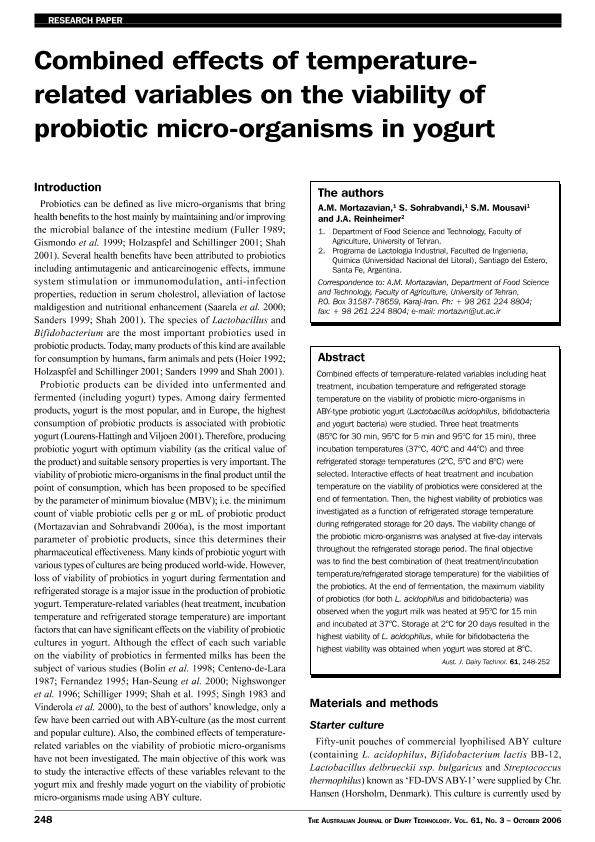Mostrar el registro sencillo del ítem
dc.contributor.author
Mortazavian, A M
dc.contributor.author
Sohrabvandi, Sara
dc.contributor.author
Mousavi, Mohammad
dc.contributor.author
Reinheimer, Jorge Alberto

dc.date.available
2021-09-09T11:52:00Z
dc.date.issued
2006-12
dc.identifier.citation
Mortazavian, A M; Sohrabvandi, Sara; Mousavi, Mohammad; Reinheimer, Jorge Alberto; Combined effects of temperature-related variables on trhe viability of probiotic micro-organisma in yogurt; Dairy Industry Assoc Australia; Australian Journal Of Dairy Technology; 61; 3; 12-2006; 248-252
dc.identifier.issn
0004-9433
dc.identifier.uri
http://hdl.handle.net/11336/139966
dc.description.abstract
Combined effects of temperature-related variables including heat treatment, incubation temperature and refrigerated storage temperature on the viability of probiotic micro-organisms in ABY-type probiotic yogurt (Lactobacillus acidophilus, bifidobacteria and yogurt bacteria) were studied. Three heat treatments (85°C for 30 min, 95°C for 5 min and 95°C for 15 min), three incubation temperatures (37°C, 40°C and 44°C) and three refrigerated storage temperatures (2°C, 5°C and 8°C) were selected. Interactive effects of heat treatment and incubation temperature on the viability of probiotics were considered at the end of fermentation. Then, the highest viability of probiotics was investigated as a function of refrigerated storage temperature during refrigerated storage for 20 days. The viability change of the probiotic micro-organisms was analysed at five-day intervals throughout the refrigerated storage period. The final objective was to find the best combination of (heat treatment/incubation temperature/refrigerated storage temperature) for the viabilities of the probiotics. At the end of fermentation, the maximum viability of probiotics (for both L. acidophilus and bifidobacteria) was observed when the yogurt milk was heated at 95°C for 15 min and incubated at 37°C. Storage at 2°C for 20 days resulted in the highest viability of L. acidophilus, while for bifidobacteria the highest viability was obtained when yogurt was stored at 8°C.
dc.format
application/pdf
dc.language.iso
eng
dc.publisher
Dairy Industry Assoc Australia

dc.rights
info:eu-repo/semantics/openAccess
dc.rights.uri
https://creativecommons.org/licenses/by-nc-sa/2.5/ar/
dc.subject
PROBIOTICS
dc.subject
YOGURT
dc.subject.classification
Alimentos y Bebidas

dc.subject.classification
Otras Ingenierías y Tecnologías

dc.subject.classification
INGENIERÍAS Y TECNOLOGÍAS

dc.title
Combined effects of temperature-related variables on trhe viability of probiotic micro-organisma in yogurt
dc.type
info:eu-repo/semantics/article
dc.type
info:ar-repo/semantics/artículo
dc.type
info:eu-repo/semantics/publishedVersion
dc.date.updated
2020-10-22T18:25:44Z
dc.journal.volume
61
dc.journal.number
3
dc.journal.pagination
248-252
dc.journal.pais
Australia

dc.description.fil
Fil: Mortazavian, A M. University of Tehran; Irán
dc.description.fil
Fil: Sohrabvandi, Sara. University of Tehran; Irán
dc.description.fil
Fil: Mousavi, Mohammad.
University of Tehran; Irán
dc.description.fil
Fil: Reinheimer, Jorge Alberto. Consejo Nacional de Investigaciones Científicas y Técnicas. Centro Científico Tecnológico Conicet - Santa Fe. Instituto de Lactología Industrial. Universidad Nacional del Litoral. Facultad de Ingeniería Química. Instituto de Lactología Industrial; Argentina
dc.journal.title
Australian Journal Of Dairy Technology

Archivos asociados
